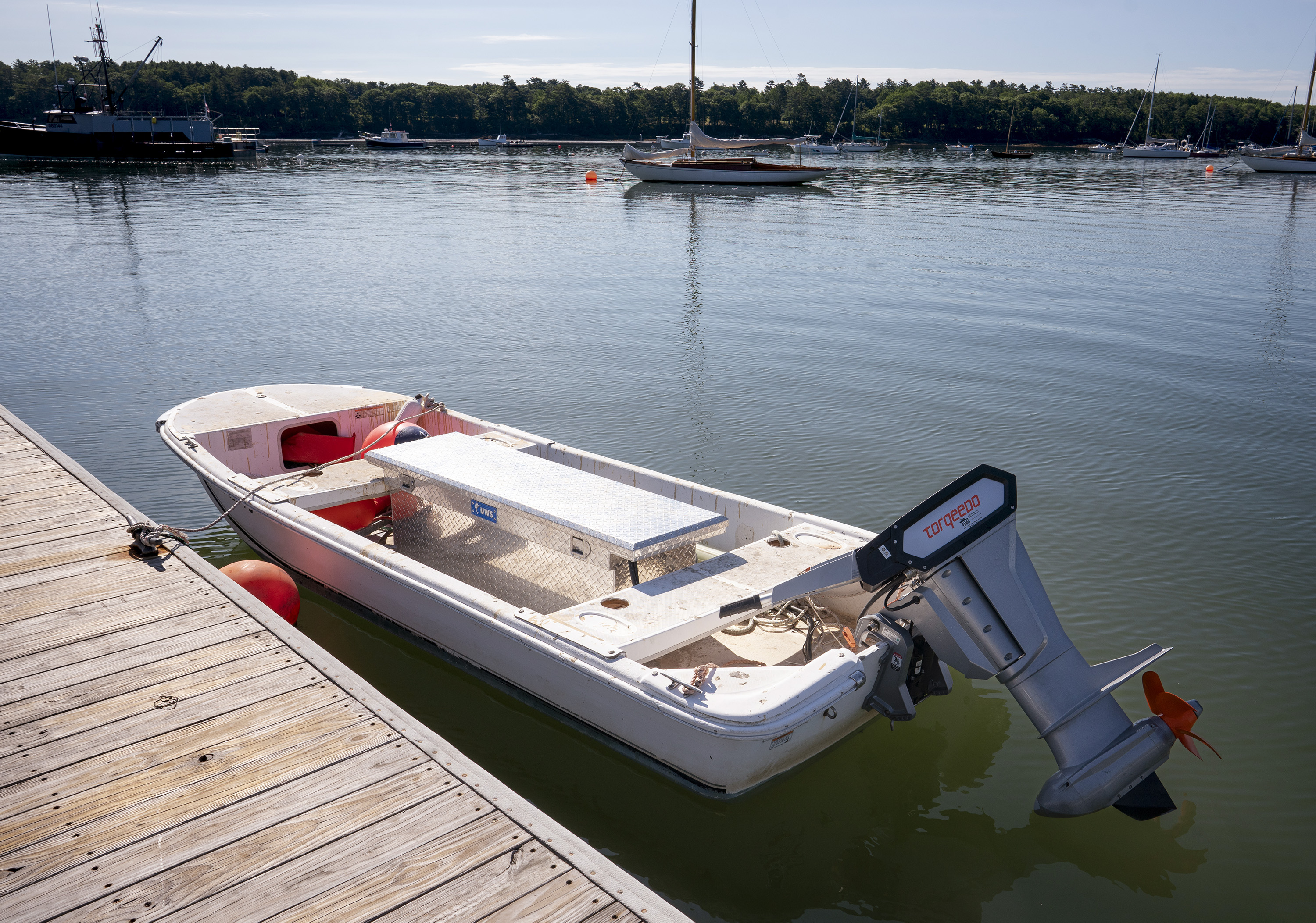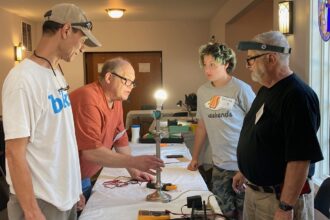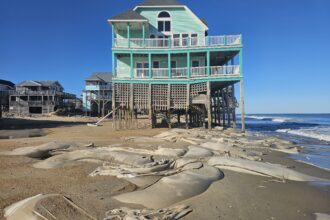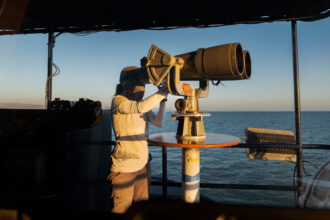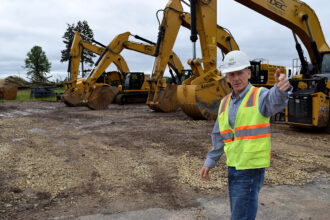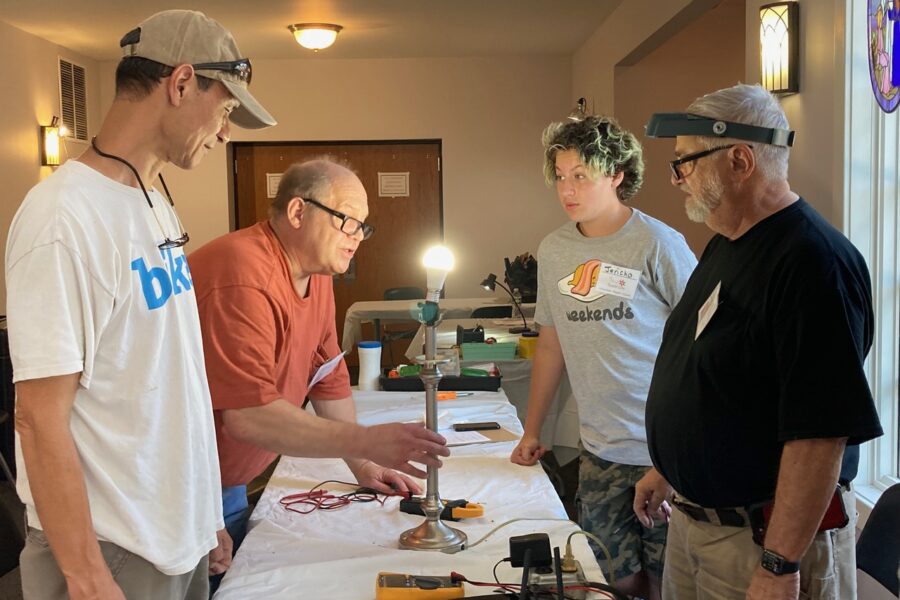Anyone who has visited a port or harbor knows that it can be an overwhelmingly sensory experience—from the pungent tang of diesel or gas exhaust to the deafening rumble of a boat’s outboard motor engine. But these engines and their emissions can have some risky consequences, fueling both global warming and health problems.
They’re also just plain annoying, according to Maine local and boater Nick Planson.
“Imagine you’re out on an oyster farm on a beautiful bay in Maine … but all day long, you’re standing next to this loud generator, and the neighbors across the bay don’t like it, the workers don’t like it,” he told me. “It’s hard to hear each other, and you’re spending lots of time schlepping gasoline around.”
Planson is among those working on a solution. The founder and CEO of the startup Shred Electric, he and his team are developing boats equipped with electric, rechargeable outboard motors geared toward shellfish farmers and small boat users.
A small but growing cadre of businesses, nonprofits and governments around the world are trying to electrify working waterfronts and ferries to minimize their emissions. But with high upfront costs and unique engineering challenges, these projects face some steep hurdles preventing them from really setting sail, experts say.
Early Adopters: The Gulf of Maine hosts some of the most productive fisheries in the United States. However, it’s also one of the fastest-warming bodies of water in the world, heating up more quickly than 99 percent of the ocean between 2004 to 2016. This climate impact has had cascading effects on New England’s working waterfronts, causing sea level rise, worsening flooding and driving mass die-offs of key species such as lobster and oyster, according to a 2020 federal report.
Electric boats could help workers avoid contributing to their fisheries’ demise, said Lia Morris, the senior community development officer at the nonprofit Island Institute. In recent years, the group has helped businesses fund and build around two dozen electric boats, including one developed by Planson’s company. Morris said it is key to get a small contingent of electric boats on the water for people to see how they work, especially because the initiative is still in its early stages.
“We feel pretty strongly, based on the small data pool that we have, that this is a smart climate solution,” she told me.
Boat electrification is slowly catching on in regions beyond Maine. In Nova Scotia, the Membertou First Nation is working with boating firms to develop the country’s first electric lobster fishing vessel, SeafoodSource reports. Meanwhile, states across the U.S., including Washington, New York and California—as well as abroad in Amsterdam and London—are increasingly developing electric or hybrid ferry boats and hydrofoils for public transportation.
Last year, my colleague Phil McKenna covered an ongoing effort in Michigan to convert the coal-powered S.S. Badger, a 410-foot freight and passenger ferry that crosses Lake Michigan each summer, to a more sustainably powered system. The company that owns it is exploring several technologies, including battery-powered electric motors and diesel-electric hybrid power paired with carbon capture for the CO2 released from burning diesel.
Choppy Seas: Experts say the boat electrification push is slowgoing, and still in its early stages due to some significant challenges. The main hurdle? Its price tag.
For example, Washington state, which operates the largest passenger ferry system in the country, kickstarted in 2020 what is now a $6 billion electrification program that aims to convert its entire fleet—currently 21 ferries—to diesel-electric hybrid power by 2040. Since the state launched its first hybrid ferry in July, it’s been pulled from service three times due to mechanical issues. The government said that is typical of a refurbishment like this, WorkBoat reports.
Even smaller workboats have a hefty upfront cost compared to traditional diesel-powered watercraft. Planson’s electric watercraft cost $100,000 to build and outfit with a single electric outboard motor, and others like it are even more expensive, especially larger boats, Canary Media reports. These projects, like much new technology, have also relied heavily on grants from nonprofits and federal agencies.
More broadly, transitioning to electric boats on working waterfronts will require infrastructure to support them, including charging stations and mechanics with expertise in repairing that equipment. This would be a sea change for the more rural fishing communities that have long worked with diesel or gas engines and lack grid access to support charging stations. It’s unclear if federal grant programs to support electrification will continue under the Trump administration.
“The federal conditions are not great right now,” Morris said. Her team is focused on the boat electrification work “that we can do at the state level while we wait hopefully for the federal winds to be more favorable again.”
And progress is still happening—albeit slowly, Morris said. Little wins help her stay optimistic, such as last week’s unveiling of Maine’s first electric boat charger in Portland Harbor.
“We’ll keep squirreling away and figuring out the shore-side charging and infrastructure piece,” Morris said. “But the big policy levers and the finance mechanisms are the things that would really ultimately help this technology get to scale and be more accessible.”
More Top Climate News
By equipping monarch butterflies with tiny solar-powered radio tags, scientists are tracking for the first time the full migration of these insects across much of North America, Dan Fagin reports for The New York Times. Experts have long worked toward this feat, which could help us learn about the secret lives of butterflies, bees and other flying insects as they face mounting threats from climate change and habitat loss.
“There’s nothing that’s not amazing about this,” Cheryl Schultz, a butterfly scientist at Washington State University, told the Times. Now, she added, “we will have answers that could help us turn the tide for these bugs.”
The tags were developed by the company Cellular Tracking Technologies. People can follow the progress of individual butterflies on a free app, called Project Monarch Science.
A pilot program in Florida is helping train birthing assistants known as doulas to prepare pregnant people for the effects of climate change on maternal and child health, Jessica Kutz reports for The 19th. Pregnant people are disproportionately vulnerable to certain climate impacts, particularly extreme heat, which can increase the risk of preterm and early term babies. Weather disasters like hurricanes and wildfires are also correlated with higher rates of maternal mental health risks, such as postpartum depression. The doula program has been running for about a year and aims to expand training beyond Florida.
The acting head of the Federal Emergency Management Agency, David Richardson, resigned on Monday, after around six months in the job, Brianna Sacks reports for The Washington Post. Richardson was criticized for his response to the deadly floods that tore through Texas Hill Country, during which emergency responders and officials could not reach his office. Current agency employees told the Post that Richardson was fairly inaccessible throughout his tenure in the position. The Trump administration said that FEMA’s current chief of staff, Karen Evans, will “step into this important role” starting in December.
Postcard From … British Columbia
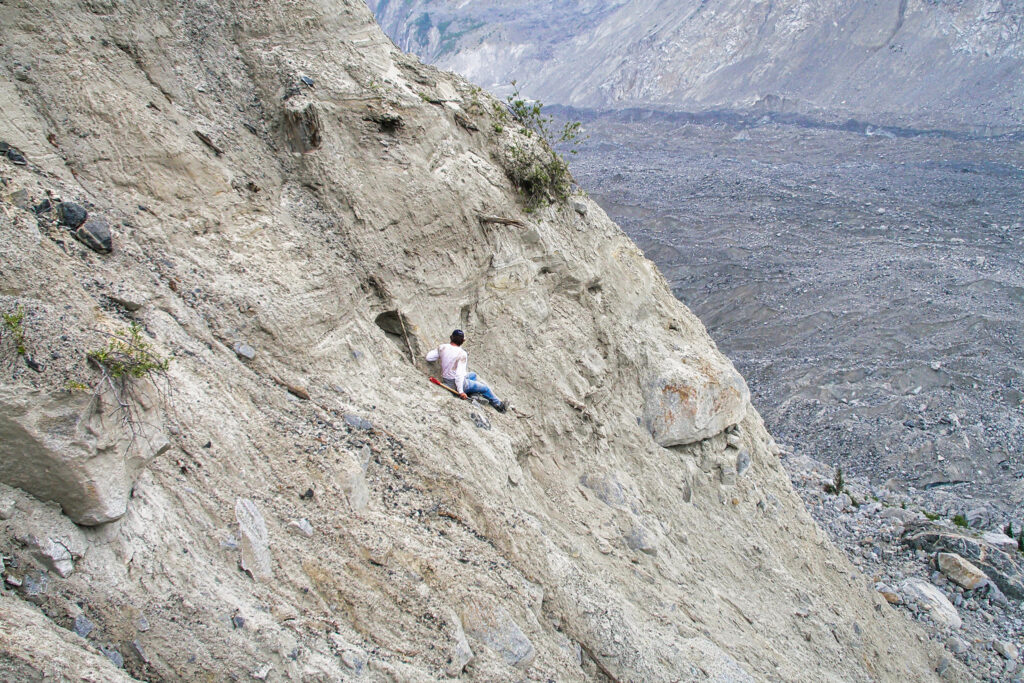
For this installment of “Postcards From,” Today’s Climate reader Jerry Osborn sent a photo of his colleague John Clague collecting wood fragments embedded in a lateral moraine of the Tiedemann Glacier in the Coast Mountains of British Columbia. They are both part of a team from Simon Fraser University, the University of Northern British Columbia and the University of Calgary that is studying these geological formations.
“Radiocarbon dating of the wood is used to determine the history of natural small-scale glacial and climate history; the latter provides comparative context for the study of anthropogenic climate change,” Osborn said.
Today’s Climate readers, please keep sending in your photos for our “Postcards From” feature to [email protected]. We love seeing how you all interact with nature, whether birding in your backyard or hiking on vacation.
About This Story
Perhaps you noticed: This story, like all the news we publish, is free to read. That’s because Inside Climate News is a 501c3 nonprofit organization. We do not charge a subscription fee, lock our news behind a paywall, or clutter our website with ads. We make our news on climate and the environment freely available to you and anyone who wants it.
That’s not all. We also share our news for free with scores of other media organizations around the country. Many of them can’t afford to do environmental journalism of their own. We’ve built bureaus from coast to coast to report local stories, collaborate with local newsrooms and co-publish articles so that this vital work is shared as widely as possible.
Two of us launched ICN in 2007. Six years later we earned a Pulitzer Prize for National Reporting, and now we run the oldest and largest dedicated climate newsroom in the nation. We tell the story in all its complexity. We hold polluters accountable. We expose environmental injustice. We debunk misinformation. We scrutinize solutions and inspire action.
Donations from readers like you fund every aspect of what we do. If you don’t already, will you support our ongoing work, our reporting on the biggest crisis facing our planet, and help us reach even more readers in more places?
Please take a moment to make a tax-deductible donation. Every one of them makes a difference.
Thank you,


